Spanish scientists collaborate in studies of milk consumption by Europeans
Monday, November 30, 2015
Last summer --and before-- I heard speaking out against human consumption of milk, by adults. And, just in summer, I listened, on the radio, to a Spanish scientist (of a Centre for the Study of Food), talking about the problem of milk: that many people were saying that it is not good for adult humans drink milk. But this Spanish scientist explained that the fear drinking milk had been originated after the writing by a Swedish doctor, who was contrary to the consumption of milk, in adulthood. The Spanish scientific --I think wisely and with checked information-- clarified the reason was that the rate of lactose intolerance is very high, in Sweden --not so in other European countries, such as for example in Spain--.
Then,last Friday, I read a news about the human consumption of milk. I have thought that perhaps you are interested, in this theme, and you would like to read a post about it.
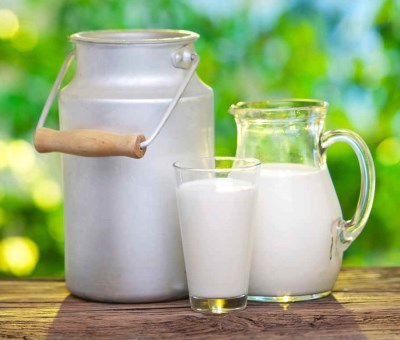
4,000 years ago, Europeans acquired the ability to digest milk, beyond infancy; a change, marked by the appearance of a related gene to persistence of the enzyme lactase, on the continent. This is one of the main findings of an investigation, conducted by an international team, involving scientists of the Higher Council for Scientific Research (CSIC), which has determined the most common genes, in Europeans, over the last 8,000 years.
The findings, published in the latest issue of the journal “Nature”, were obtained by analyzing the genomes of 230 individuals of the European prehistory, including 15 from the “Cueva del Mirador”, in Atapuerca (Burgos).
The work, led by scientists at the Broad Institute of Harvard University (USA), the University College of Dublin (Ireland) and the Max Planck Institute (Germany), highlights 12 genetic variants, selected over thousands of years, as a response to various adaptive challenges. The samples include, for the first time, Neolithic genomes from Anatolia (Turkey), dated to over 8,000 years ago.
Currently, the mutation of the gene of the lactase, that ensures its persistence, is present in 100% of Europeans, in Northern Europe. "This is probably the feature that shows greater survival advantage, for the Europeans, ie, the genetic trait, that evolution has selected, with greater intensity. 4,000 years ago, it was a residual mutation, which means that it was later selected, by the European populations, by the great advantage, that supposed to have milk as a food source during adulthood", explains the researcher of the CSIC, Carles Lalueza-Fox, from the Institute of Evolutionary Biology (a joint Centre of the CSIC and the Universitat Pompeu Fabra, in Barcelona).
The ability to digest milk is one of the many adaptations, that arose with the advent of agriculture and livestock, in Europe, 8.500 years ago. New environments, pathogens, allowances and social organizations marked the evolution of these Neolithic populations. Although the exact origin of the mutation of the enzyme lactase is unknown, scientists have found it, for the first time, in people from the central and northern Europe, who lived in the late Neolithic. Specifically, it is in the analyzed samples from Sweden, Hungary and Germany, which have a length of just over 4,000 years.
"The mutation is not required if you process milk, for example, to make cheese; therefore, it does not mean that these people do not took advantage of this resource before. Around the Copper Age, the strong influence, that central Europe receives from the nomads of the steppes, could indicate that they were who introduced the genetic change, on the continent, but no one knows exactly", says Lalueza-Fox.
The scientists have found mutations, involved in the current light-skinned of Europeans, absent traits in populations of hunter-gatherers of the Mesolithic (between 10,000 and 5,000 years ago), like in “the man from La Braña”, a man from León (North west of Spain), who roamed the Peninsula 8,000 years ago and was characterized, by his dark skin and blue eyes. This last feature, was prevalent in the Mesolithic in Europe.
The work indicates other aspects, that depend on hundreds of genes, such as height, which was decreasing, in the Iberian populations, from the Neolithic. This part of the study had a relevant role the analysis of 15 samples, from the Copper Age, dating back between 4,800 and 4,200 years of El Mirador in Atapuerca. These data add to the recent publication of seven genomes of the same age from other site of Atapuerca: El Portalón.
Some of the genes, selected by Europeans, have a biomedical interest and have been related, concretely, to the celiac disease. The scientists have observed mutations, in a gene, to protect against the lack of ergothioneine, an antioxidant, in diets based on farming. Other mutations are associated with ulcerative colitis or irritable bowel syndrome.
For Josep Maria Vergès, a researcher at the Catalan Institute of Human Paleoecology and Social Evolution, "the gotten data are critical for understanding the role played, by cultural adaptations, in the genetic makeup of European populations, in recent prehistory". According Lalueza-Fox, the study "is the first step, to understand how human populations have evolved, in recent times. The oldest sample analysis, in the future, will reveal minor episodes of selection, at regional level ".
Well, I hope that you are agrre with this news. I think that it is surely true that many people have intolerance to the lactose and it is a pity, because milk is a great source of calcium.
Anyway, I think that it is great to have so much information, to any matter, in our lives.
Until my next post, kind regards,
Luis.
Sponsored by Costaluz Lawyers.
Please click below:

 0
Like
Published at 11:57 AM Comments (1)
0
Like
Published at 11:57 AM Comments (1)
Mycology in Southern Spain
Thursday, November 26, 2015
The last Saturday, in the morning, I could listen, on the radio, a comment about Mycology in Spain; yes, because two famous Spanish journalists were talking about the wonderful experience of picking mushrooms, in the Valley of Ezcaray, on the occasion of the XXIV Mycological Conferences Friends of Ezcaray, celebrated from last October 30 to November 8. (Ezcaray is a pioneer municipality, arranging Mycological Exhibition in Spain). So, I thought that, probably, you would like to know how the world of mycology, in southern Spain --and particularly in the Gibraltar Field—, is.
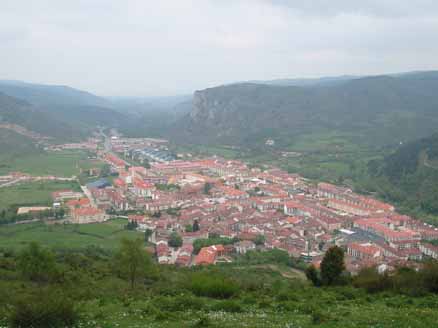
Ezcaray (La Rioja), Northwest of Spain
Please, look how nice the poster, that announces “The third Mycological Conferences of the Strait”, is.
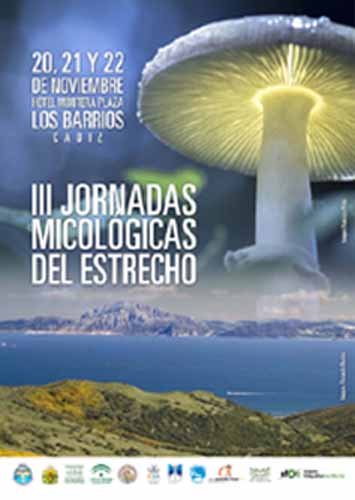
These are some days of educational and scientific character, on the knowledge of our region of Gibraltar Field. A natural richness, little bit knownof our natural environment and mycological richnes and less known recognised. Conferences, mushroom picking, identification and practices. Taught by renowned speakers.
The last day 13, the jury of the First Photo Contest "Mushrooms from Los Alcornocales" was met. The day 16, the awards were presented and, after that ceremony, the Exhibition of the Photographs was opened, in the Hotel Montera, in Los Barrios (Cadiz).
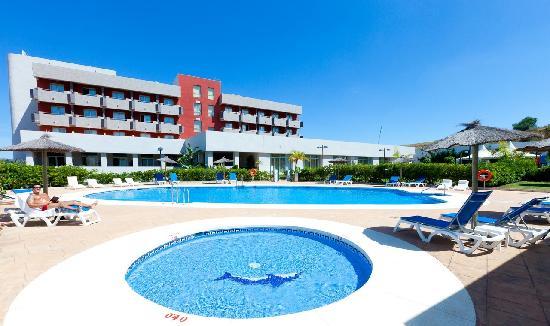
Hotel "Montera Plaza"
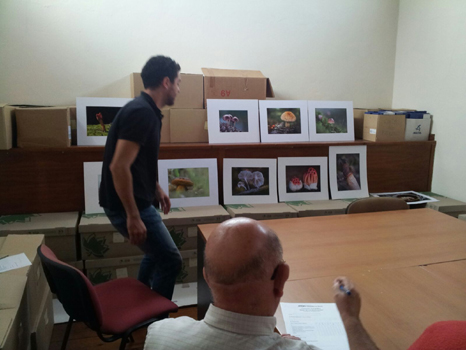
Photographs for the Contest
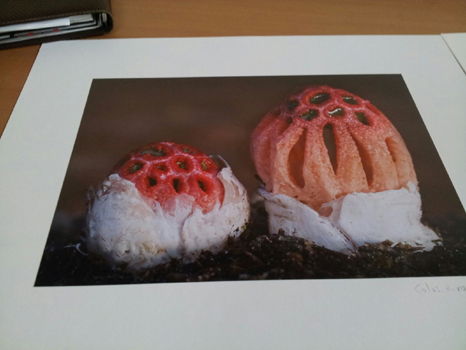
The last day 14, an “Initiation Workshop to the Mycology”, with AAVV Lazareto, was done. Alejandro Valle gave a talk.
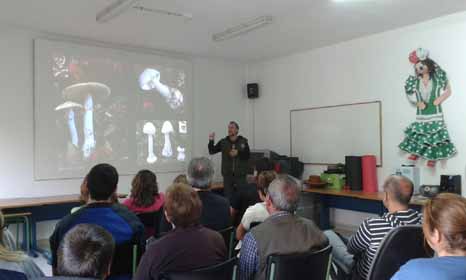
Alejandro Valle giving a talk
But, they also went to field, in order to search mushrooms, as you see below. And they followed with another activities, the rest of the week.
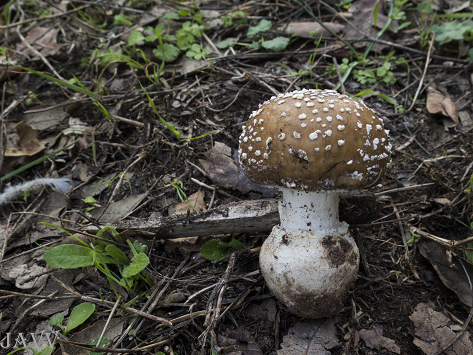
Mushroom named: "Amanita Pantherina"
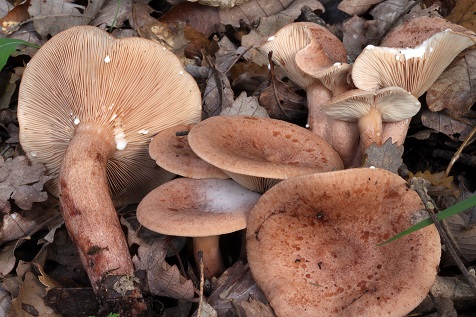
Mushroom named: "Lactarius Chrysorreus"
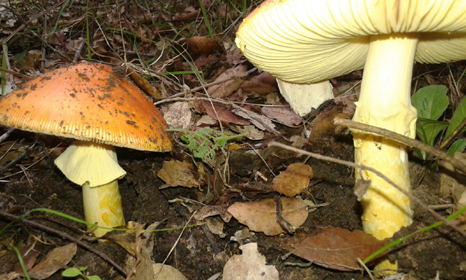
Mushroom named: "Amanita Caesarea"
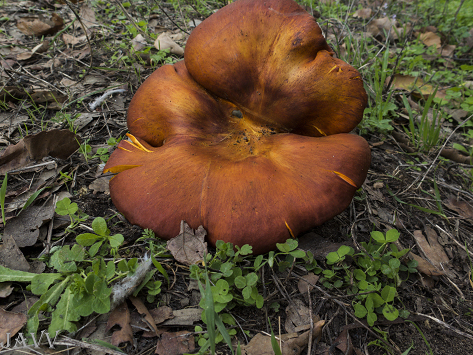
Mushroom named: "Omphalotus Olearius"
I think this world of mushrooms is very interesting --though I do not understand anything about it--. Maybe you are interested, in knowing it or perhaps you are an amateur and you want to attend, next year, to the possible IV Mycological Conferences of the Strait. In that case, you will have to send an application form, to the Association Marei, in Algeciras, (mareiama@gmail.com) and pay 20 Euros. If you have any question, please call the telephone number 637 571 835.
Well, I hope that you have liked this post and I also hope that you can comenext year, to Los Barrios.
Until my next post, kind regards,
Luis.
Sponsored by Costaluz Lawyers.
Please click below:

 0
Like
Published at 11:27 AM Comments (0)
0
Like
Published at 11:27 AM Comments (0)
Cooked loin in an earthenware pot in Spain
Wednesday, November 18, 2015
Today I want to show you a recipe, known in any part of Andalusia as “Lomo de orza” (Cooked loin in an earthenware pot). It is known throughout Andalusia, because to cook, is used a vessel of which there are up to six types, depending on the area; this vessel is called "Orza" and it is usually made of clay --although you can also use a jar--.
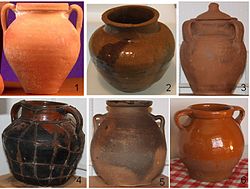 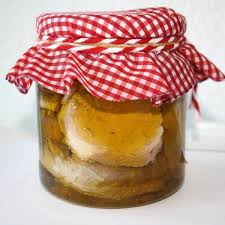
Now, I am going to tell you what ingredients you need to cook this dish for four persons: 500 grams of pork loin. Olive oil. For the marinade: 3 cloves of garlic. 250 grams of oil. 150 grams of apple cider vinegar. 1 small spoon (for coffee) with sweet paprika. 1 small spoon with oregano. 1 small spoon with fine salt.
Well. For the making, you have to do the following: In a bowl, make it a little just for meat, put the garlic cloves, minced as thin as possible, oil, vinegar, salt, and stir, until everything is emulsified. Leave the meat in the marinade, at least 24 hours.
After this time, drain the meat from the marinade and place it, in a saucepan, to make a snug, cover with olive oil and simmer for 15 minutes; let cool and keep on cooking oil in a closed pot (the best is an earthenware pot, as I said before), until use. Thus, preserved in oil, meat keeps well, up to a month.
For the presentation, you have to drain the oil, cut the meat, as thin as possible, and serve the cold meat.
And this must be the result:
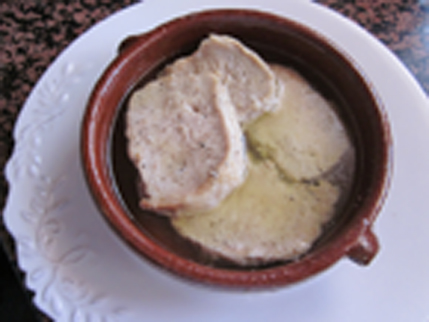
The meat into the earthenware pot
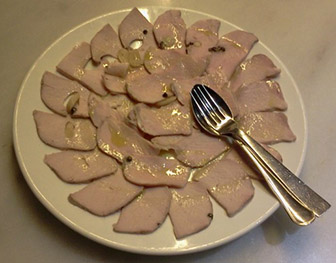
The meat on a plate
Well, I hope that you can try to cook it and tell me about the experience, if you want.
Until my next post, kind regards,
Luis.
Sponsored by Costaluz Lawyers.
Please click below:

 0
Like
Published at 11:54 AM Comments (1)
0
Like
Published at 11:54 AM Comments (1)
Spanish scientists discover a noninvasive method against brain tumors
Thursday, November 12, 2015
The day before yesterday, I watched, on television, a very interesting news, about brain tumors. Above all, the news was saying this method is non-invasive. If you want to watch this video, please click below:
http://www.antena3.com/videos-online/noticias/ciencia/puncion-lumbar-permitira-detectar-existencia-tumores-cerebrales_2015111000802.html
Vicente Vallés (Presenter of the Newscast in Antena3, at three o´clock): “Today, we speak you of a hopeful breakthrough in the treatment of brain tumors: researchers from the VaII d'Hebron Hospital, in Barcelona, have presented a technique, that allows more simple treatment. That diagnostic test involves a lumbar puncture; and it is much less aggressive than those made so far. With the analysis of the liquid, extracted from the spine, you can know if there is a tumor, in the brain, and, moreover, what is your genetic profile and if you are responding to treatment. The finding also facilitate early diagnosis of brain metastasis, so that they can be treated more effectively”
Joan Seoane (Research Coordinator): “Thus, we have a process, that is minimally invasive, it can be repeated, if necessary, and allows us to characterize very well, how the tumor is and how we can treat it”.
Well, I hope that you do think, as I do, that it is a very important step forward in the fight against cancer.
Until my next post, kind regards,
Luis.
Sponsored by Costaluz Lawyers.
Please click below:

 1
Like
Published at 9:24 AM Comments (0)
1
Like
Published at 9:24 AM Comments (0)
A great Spanish musician so loved all over the world
Wednesday, November 11, 2015
The day before yesterday, it was celebrated the 75 Birthday of a so famous piece by the Spanish musician, Joaquín Rodrigo "The Concert of Aranjuez"; so, I should like to show you that piece, in two versions: one classic, with pictures from La Alhambra (Granada, South eastern Spain), and another modern, by Paco de Lucía and an Orchestra.
If you want to watch these two videos, please click on the links below:
https://www.youtube.com/watch?v=UNqtCsCqCD8
https://www.youtube.com/watch?v=hxbDLnaAvAE
Joaquin Rodrigo (Sagunto, 1901-Madrid, 1999), a time, said the sentence “My glass is small, but I drink in my glass”; he said it, many times, throughout his life; today it is still present in his epitaph. One way to define the place, in the world, of this man, who connected the oldest Spanish musical tradition with the explosion of the avant-garde and even with popular music. "The important thing was to follow my own way", the master explained, in 1991, on the occasion of his 90th birthday.
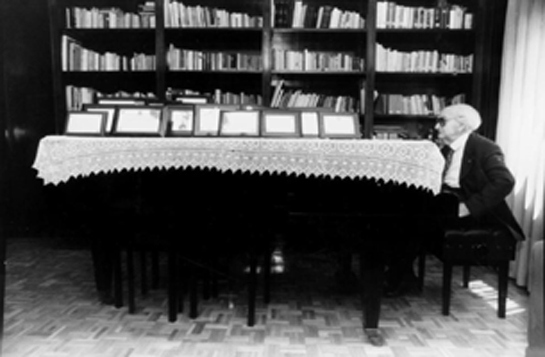
Joaquin Rodrigo and his piano
And, however, if we look at the spread and popularization of his work, the glass of Rodrigo housed one of the greatest phenomena of Spanish music of all time. Falla, Albeniz, Granados and Turina got that their pieces went out of Spain and went over the world. But none of them reached the heights it reached Rodrigo's Concierto de Aranjuez. Interpreted in thousands of versions, humed by music-lovers and profanes, a piece of reference, but which is eclipsed of the rest of the production of Joaquin Rodrigo. The Concert of Aranjuez was performed on November 9, 1940, at the Palau de la Musica Catalana, in Barcelona, played by Regino Sainz de la Maza, to the guitar, and the Philharmonic Orchestra of Barcelona, directed by Caesar Mendoza Lasalle.
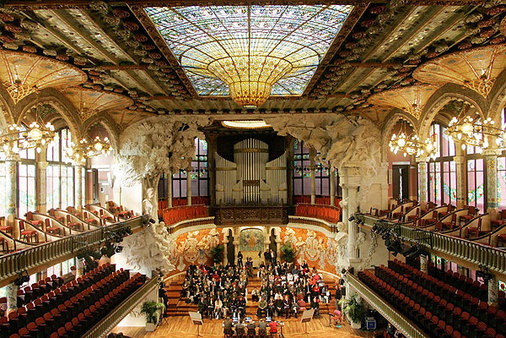
Palau of de Music at Catalonia
The piece has an air of inaugural and unique moment, for various reasons. It is the first work composed for Spanish guitar and orchestra, but also marks the beginning of the postwar period, in the musical chronology of our country, at a particularly bleak, marked by the destruction of the Civil War and exile of much of the intellectual and Spanish artists (including musicians) to America and Europe. A period also hit by the advance of Nazism, with Wagnerian alibis, destroyed, in its wake, any art that it deemed "degenerate".
In his writings, edited and available on the website of the Victoria and Joaquín Rodrigo Foundation, the composer remembers so the moment of the creation of the concert. Installed in Paris since 1927, where he studied with Paul Dukas --and he met the Turkish pianist, Victoria Kamhi, with whom he married in 1933--, Rodrigo began a trip to Spain, during the Civil War."In September 1938, I passed through San Sebastián, way to France (...) The Marquess of Bolarque brought us to eat, Regino Sainz de la Maza and me. We ate well and we did not drink bad.. The moment was conducive to fantasy and daring", evoked the composer, in a story, again, with glasses involved. "Suddenly, Regino, with that tone among fickle and determined how well characterizes him, said: - “Man, you have to come back with a concert for guitar and orchestra”. In order to touch me, he added with a pathetic voice: “It is the dream of my life” And, as it is said today, in order to suck up to me--, he continued: “You are called to do it, something like chosen”. I drained two consecutive glasses of the best Rioja and I cried with the most convinced tone of the world: “- Man, that's done!”. The scene has been deeply impressed me, because that night was a pleasant memory in my life, and a moment of peace in those (hours) nothing threatening quiet for Spain and menacing for Europe".
"The scene has been deeply impressed me, because that night was a pleasant memory in my life, and a moment of peace in those (hours) nothing quiet for Spain and threatening for Europe".
Rodrigo composed the concert, in his studio, at 159 Rue Saint Jacques, in the Latin Quarter of Paris. While the Spanish Civil War was coming to an end and the final victory of Franco, another war was brewing in Europe. "I was fond of me with the idea, to force difficult to judge, I heard me singing in the whole subject of the Adagio, in one go, without hesitation, and ... then, with little transition, the third time. I quickly realise that the work was done. Our intuition does not deceive us in this ... ", Rodrigo recalled about the writing process, during those months, in Paris. "If the Adagio and the final Allegro took me something like inspiration, that irresistible and supernatural strength, I arrived to the first time for reflection, calculation and will. It was the last time of the three of them. I finished the work over where I should must having started ".
The September 3 -1939, two days after the start of the World War II, Joaquín and Teresa entered Spain, from the French border, bringing the manuscript of the Concert of Aranjuez, in braille. Rodrigo, nearly blind, since three years, because of a diphtheria, used a particular system for transcription of his ideas. First, he writed the musical notation, in Braille, which then went over a pentagram, with the help of a copyist. Later, he performed the corrections, together with Teresa, and finally he presented the final score. A procedure that has been recently discussed, in the Residence of Students, in Madrid, by Cecilia Rodrigo, daughter of Joaquín and Teresa, on the occasion of the 75th anniversary of the premiere of the work.
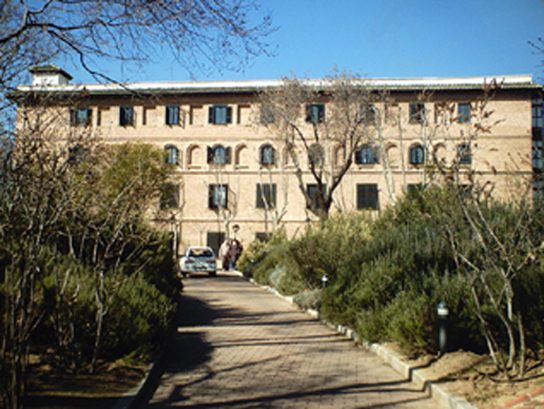
Residence of Students
The Concert of Aranjuez also represents an unique case, as it offers the listener the transmission of a very specific sensory experience, in the gardens of the Royal Palace of Aranjuez, where the birdsong, the smell of flowers and the freshness of the sources take precedence over the visual experience or the architectural enjoyment, that often inspire compositions of this nature.
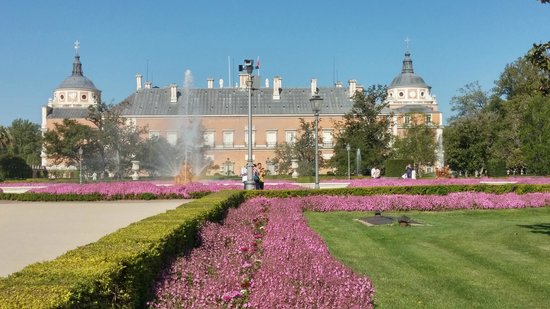
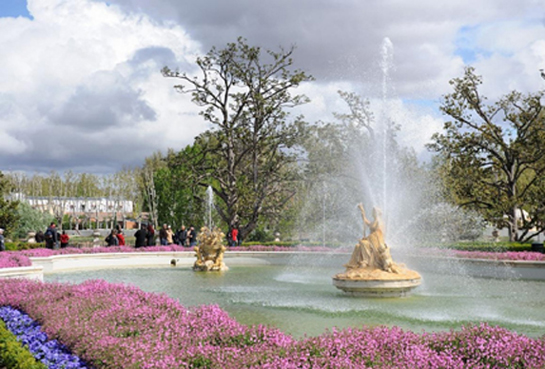
After the first concert recording, in 1948, the piece began its international journey, in 1950, with a great concert, in Paris, with Ataulfo Argenta, as director at the head of the National Orchestra of Spain, and Narciso Yepes, as lead guitarist. Ten years later, the definitive popularization came, when Miles Davis adapted the Adagio in “Sketches from Spain”. And since then, a multiplication process remain unknown purpose.
"The celebrity of a score can be never predicted", said the composer, to this newspaper, in 1991. "When I wrote it, I just thought that it went as well as possible, that it was played a lot and the public liked it. It also meant a kind of challenge, to write a concert, for guitar surrounded by an orchestra and achieve the desired balance. The case of this concert is very unusual, because it has become very popular and that does not happen with symphonic works, however good they are".
Well, I hope that you have enjoyed the two videos, at the beginning.
Until my next post, kind regards,
Luis.
Sponsored by Costaluz Lawyers.
Please click below:

 0
Like
Published at 11:41 AM Comments (0)
0
Like
Published at 11:41 AM Comments (0)
A spanish Minister who is going out in grand style
Monday, November 9, 2015
On last Friday, I could listen, on the radio, an interview with Luis de Guindos, Minister of Economy and Competitiveness of the Government of Spain. Among other things, de Guindos announced that he will not follow being a Minister, after the next December-20. So, I should like, from here, to pay a little tribute to him, for his work, as head of government, because I think that he has done a lot for Spain, that had a so difficult economic situation.
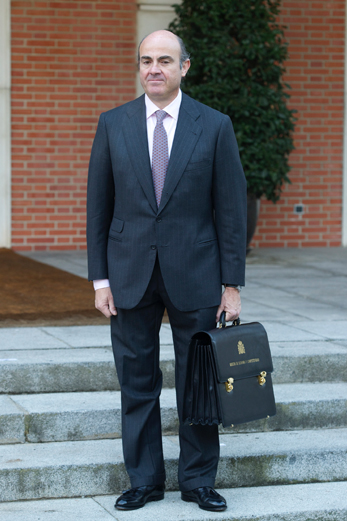
I think that Luis de Guindos has been a serious man, a discreet man, a modest man, a man who loves Spain (my country; therefore, I express thanks for him).
On the interview, he said several things like that he rules out that the government will design new cuts, after the European Commission worsen its deficit forecasts, for Spain. He has said: "We must not design new cuts, what to do is implement the budget", in which "there is no electoral component" but "support measures to economic growth".
Brussels estimates that the deficit of Spain, in 2015, will reach the 4.7% of GDP (Gross Domestic Product) and 3.6%, in 2016, (two and a tenth, respectively, than in its previous forecast). The Spanish government, however, expects a deficit of 4.2%, this year, and 2.8% next year, a target agreed with its partners.

Luis de Guindos has insisted that these differences between estimates of Brussels and the Spanish government "has already occurred in the past", but "What happens now is that we are at a sensitive time", the proximity of the General Elections, he has declared.
In any case, the holder of Economy has argued that the half point of divergence between the estimates of deficit Brussels (just over 5,000 million euros), this year, and the Spanish government "is not very important or especially relevant" and he was convinced that the figures, at the end, "will be those of the Spanish government".
The Minister also said that the Spanish government projections "have always been prudent and have been adjusted closer to reality". According to De Guindos, despite of the "uncertainties" existing, both growth at a rate of 5% of tax revenues, as "significant" savings, in interest on the debt and spending on unemployment, support the approach of the Spanish Government”.
In fact, he noted that if the uncertainty over the election results is eliminated, "the Spanish economy can give a very positive surprise, next year, and grow well above 3%", and he added: "We will have a deficit of 4.2% and below 3%, in 2016", De Guindos has riveted.
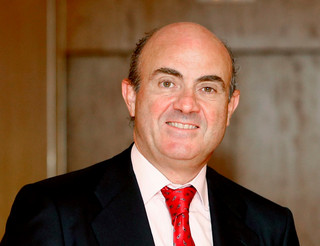
Luis de Guindos is glad
Questioned on the valuation made, by citizens of the economic situation, in the latest barometre of the Centre for Sociological Research (CIS), published on thursday, in which 24% of respondents believe that it is worse, than a year ago, and more than 21% see it better, the Minister pointed out that what matters is the trend, "that is going better".
During the interview, at RNE, the Economy Minister has been questioned by Bankia. "It has to be a separate entity. It is approximately 10% of the Spanish financial system and it has to compete with other major banks like BBVA, Santander and CaixaBank and it is an element to energize the positive necessary rivalry, that has to be in the Spanish financial system", he said.
The Minister recalled that the options and the time of sale of Bankia correspond to the next Government --it has to occur before 2017, in compliance with the memorandum of understanding, signed with Brussels-- and he stressed that "the important thing" is that the company "does not generate any problem at the Spanish financial system".
Well, I hope that you have liked the interview, such as I do.
I wish De Guindos the best of luck, to his new life, after being Minister.
Thanks, Minister!.
Until my next post, kind regards,
Luis.
Sponsored by Costaluz Lawyers.
Please click below:

 0
Like
Published at 10:24 AM Comments (0)
0
Like
Published at 10:24 AM Comments (0)
The Raor fishing in the eastern Spain
Friday, November 6, 2015
Today, I should like to show you a video, where you can watch a special fish from Baleares, named “Raor”. If you want to watch this video, please click on the link below:
http://www.rtve.es/alacarta/videos/agrosfera/agr-cmg-raor/3272741/
Voice in off: “Raor fishing (the "little parrot fish") unleashes passions between amateur fishermen, in Baleares (East of Spain). The same day, --the first of Septiembre--, when the close season is lifted, and, sometimes, challenging the status of the sea --as it happened this year—you go fishing. Arrived at destination, Pep Lluis and his children are preparing reeds, they place the bait --small prawn-- and they wait the moment comes”
Pep Lluis Serna (fisherman): “If we take the first one .... this is a little big, you have to enjoy right out; but I am in favor of that, as smaller they are, they are more good for eating, they are more palatable”
Voice in off: “It is also common that, at this time of year, reeds rise “Pajeles” ("sea bream") and "Pedasos" (the famous "fish Bothus Podas"), similar to sole ... However, the objective, pursued and longed more are "Raós "”
Pep Lluis: “You have to wait until September 1, to get out to catch it, then people ... it is not like going to the mountain or cows, that you can go all year, this fish, as you have a season, people go like crazy to catch it, it is normal”
Lluis Mestres (Reporter on the Editorial office Baleares): ”The start of the season of fishing “Raor”, the "parrot fish" since ever calls together, in Baleares, hundreds of fishermen, who go out to sea; they do not want to miss the opportunity, to capture, to catch this prized fish”
Pep Lluis: “Here, we are going crazy to get it; so, for this reason, in the Market El Olivar, if you go to buy it, sometimes it has been to 90 Euros per kilogram .... all are tastes .....; man, I supose it is normal that who buy the fish is because it can not go to catch it; and there are people who are fanatical ...: just as there are people, who like to eat a piece of lobster, this fish is so prized”
Luis Mestres (Voice in off): “The Raor, in the Central Market of Palma (the Marke of the Olivar), exceeds 60 Euros per kilo; it contrasts with the price of the Llampuga --another popular fish, that, in its passage through the Balearic Islands, it is subject to significant catches”
Well, here has finished this video and I hope that you have liked it.
Until my next post, kind regards,
Luis.
Sponsored by Costaluz Lawyers,
Please click below:

 0
Like
Published at 11:01 AM Comments (0)
0
Like
Published at 11:01 AM Comments (0)
Tabanco in the south of Spain
Wednesday, November 4, 2015
Last Saturday, I was, in Jerez de la Frontera (Cádiz), and walking on the centre, I found a place that was called "Tabanco the Passage"; I went into and asked the owner if he let me take some pictures, she said yes; when I asked what "Tabanco" meant, he told me that it was a "Tavern", but only in Jerez, not in the rest of Spain. So, while I did the photographs, the owner told me that, formerly, there were selling wine and tobacco, --when tobacco entered in Spain--, and, then, only as an office that bought wine. But, at the Tabancos, also there were performances by Flamenco.
Indeed, Tabanco was a establishment, which emerged, in Jerez, and that mixed the social concept of tavern and the commercial vocation of "wines shop", mainly Jerez and its distillates. In these establishments, wine was sold in bulk, moreover you could taste wine and other foods, in the same property. Nowadays, they still offer you some “tapas”, with wine.

Wine and tapas in the Tabanco "The Passage"
The name "Tabanco" emerged, in the seventeenth century, and it came from the fusion of two words: "government shop" (sale controlled by the state) and "tobacco" (a new product reached that century) .Other theories suggest that the designation of “tabanco” born in the early twentieth century, when it was contained in documents, replacing the word tavern. Although Cervantes described, in a poem of his book "Travel to the Parnassus", mentioning the Gitanilla:
Nunca se inclina, o sirve a la canalla
trobadora , maligna y trafalmeja ,
Que en lo que mas ignora , menos calla.
Hay otra falsa , ansiosa , torpe y vieja ,
Amiga de sonaja y morteruelo,
Que ni tabanco , ni taberna deja
The poem in English:
Never lean or serves the scoundrel
troubadour, malignant and trafalmeja,
That what most ignorant, less silent.
There is another false, anxious, clumsy
and old,
Friend of rattle and Morteruelo (it is a
typical stew from Cuenca, that is cooked
with pork liver and sometimes with
chiken, ham and bread crumbs),
That neither tabanco, or tavern leaves.
They were meeting places, belonging to the circuit where wine was served, it was sung flamenco, flamenco singers were promoted. The image of a Tabanco is composed of a desk, generally of wood, staffed by one or several people, showing old oak barrels, in which the drink is preserved.
Although the alarm for possible disappearance occurred in 2001, they have now proliferated new tabancos, combining ancient tradition with modernity, getting to create a specific route.
Well, the Tabanco "The Passage" is in the street Santa Maria, number 8; It is near the Villamarta Theatre --which I saw, at the beginning of the morning, before finding the Tabanco El Pasaje--. Next to the theater, I had breakfast, on the terrace of a coffee shop, because the weather was good.
I am going to show you a plan of an area of the city:
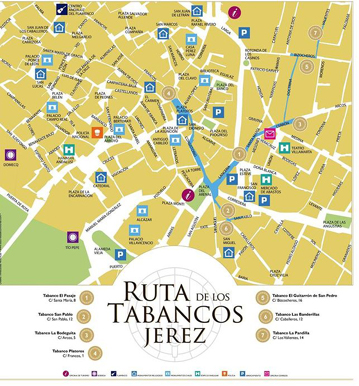
Look at the Tabanco The Passage on the number 1, to the right side of the plan.
It is said the the Tabanco El Pasaje is the oldest tabanco in Jerez, because it was open, by its first owner, Mr. José González Navarro, in 1925 – December 16 --a year of memory lavish, as the kings of Spain, Alfonso XIII and Victoria Eugenia of Battenberg, came to crown the Virgin of El Carmen, in the Park González Hontoria; having cause of that reason, to such diverse cultural events, opera and bullfight--.

The Tabanco "The Passage" in 1925.
But "The Passage" had been, before, in the early twentieth century, greengrocer´s and then headquarters of a group, where the waiters of Jerez got together, going in the early twenties to become the tabanco "La Fortuna", by Mr. Domingo Jimenez, until to change its name, in 1925, adopting the current of "The Passage", because the shop has two entrances to it: the main one, along the Santa Maria street number 8 and the back, along the Mesones 7 street.
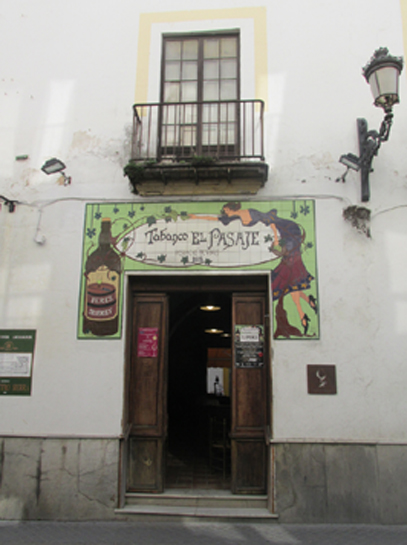
Currently, the new direction of this house has rescued a part of the accessory that remained boarded up, since immemorial time, recovering hewn stone of it, and giving this typical tabanco a more comfortable appearance, being able to install some watchmen, for its esteemed clientele, in that space.
I went into the Tabanco and I asked the owner for permission to make some pictures inside. Then, I could make –although there was a low light— some pictures like these:
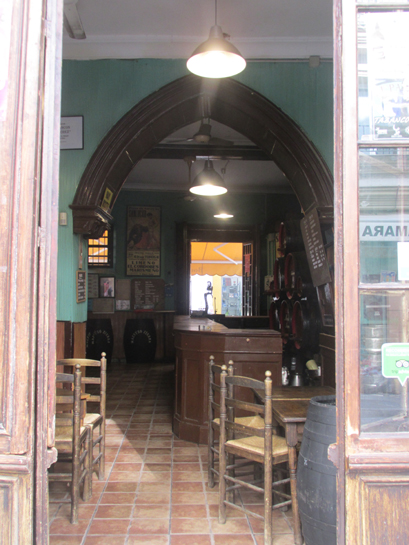


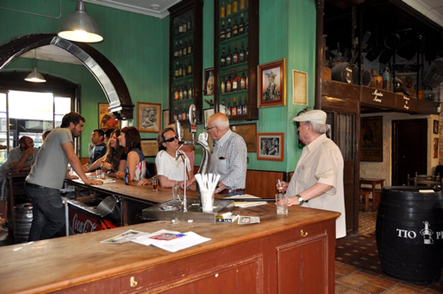
The different types of wines, that traditionally are sold, in this old and popular tabanco, kept in small barrels, from which it is extracted directly to public view, belong to the accredited winemaking firm Maestro Sierra, with unsurpassable quality, that it distinguishes its different products.
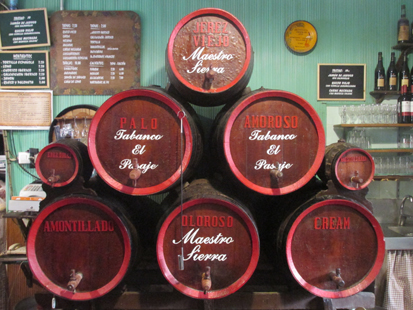
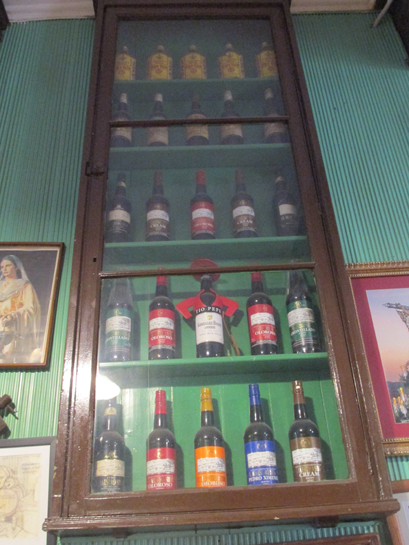
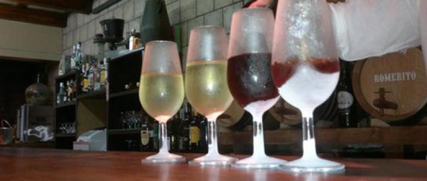
"Catavinos" (wine taster´s glasses) with differents types of wine of Maestro Sierra
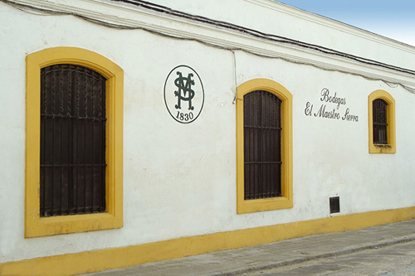
The Winery Maestro Sierra
Going to back of the shop, I stayed looking at a picture of a young butfamous “Cantaor” (Singer of Flamenco), from the beginning of the twenty century and named Manuel Valencia Peña, but named “Diamante negro” (“Black Diamond”). The tabanco´s owner told me that Manuel was a very good singer of Spanish Copla.
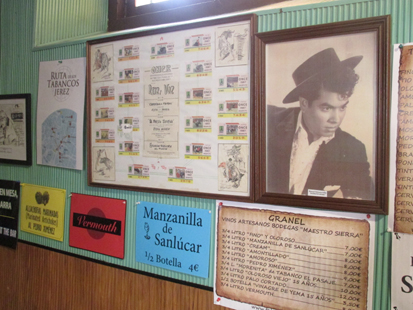
The "Diamante negro" on the right side of the picture
Looking to the left, I could see the corner of the tabanco, where they offer a spectacle of Flamenco, every night, at 9 and a half.
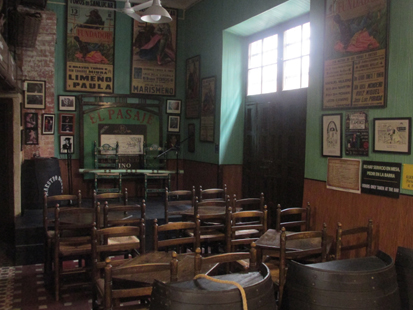
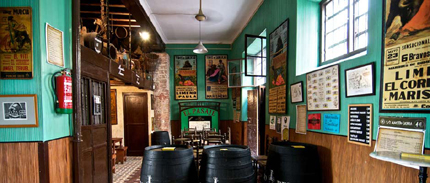
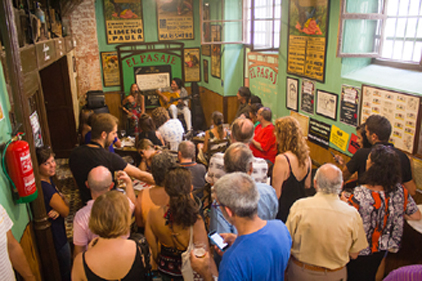
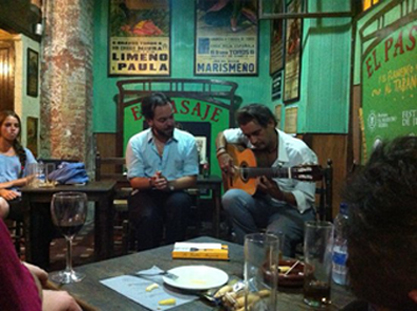
Jaime Candié and Ramón Trujillo
Going out of the tabanco, in front of it, I could see a very nice shop, “TAMARA”, specialized in clothes and accessories for Flamenco.

Then, María (my wife), our children and I went, to the Arenal Square, in order to take our car, which was in an underground car park. But, before it, I made some pictures to the square and to the main market –where I was impressed with so many stalls of fish……--.
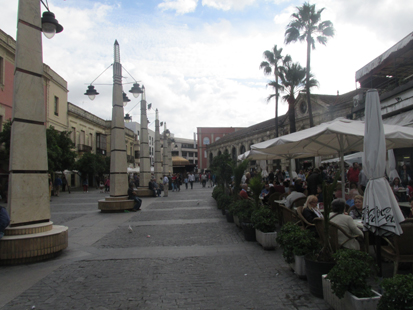
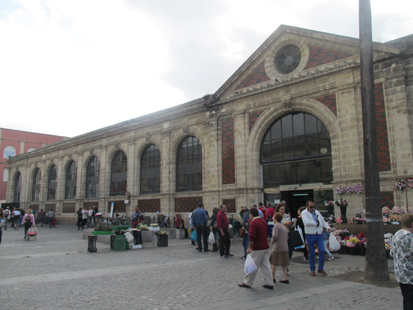
The Market
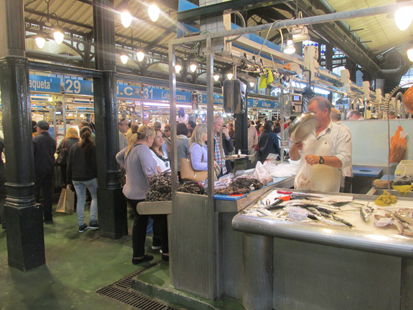
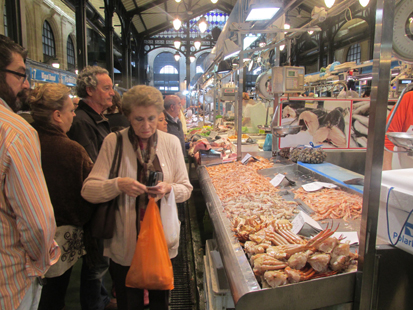
Well, I hope that you have liked to read my little experience, in the centre of Jerez, and I hope that you can enjoy a similar tour yourself anyday.
Until my next post, kind regards,
Luis.
Sponsored by Costaluz Lawyers.
Please click below:

 2
Like
Published at 11:23 AM Comments (1)
2
Like
Published at 11:23 AM Comments (1)
Spam post or Abuse? Please let us know
|
|